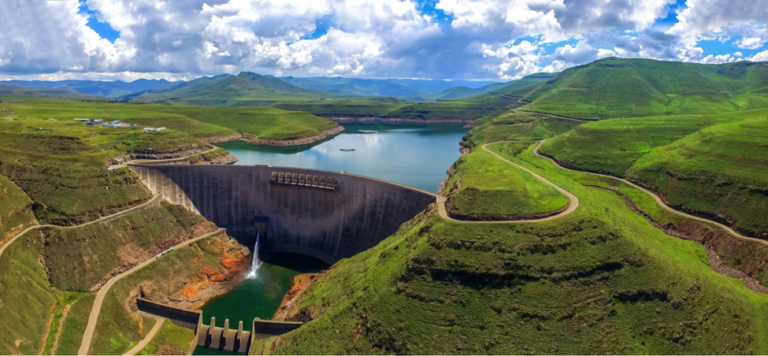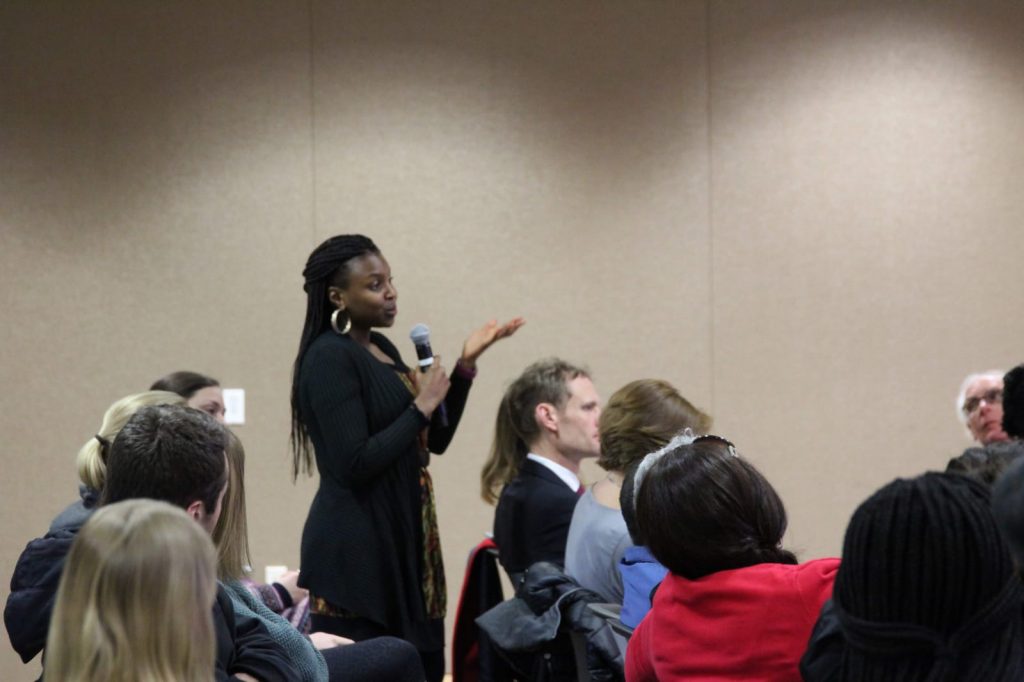The Lesotho Highlands Water Project’s Perpetuation of Inequity and Food Insecurity Among Women

Emily Gould, Research Fellow, Resource, Environment, and Energy Policy Lab
egould@africacfsp.org
The construction of the Lesotho Highlands Water Project (LHWP) has led to immense advancements in Lesotho’s energy sector and economy while also providing valuable water resources to South Africa. Unfortunately, this project’s construction has left many citizens of Lesotho displaced over the last couple of decades. Of those impacted, women suffer at disproportionate rates from food insecurity and financial instability caused by the construction of the LHWP. To mitigate the negative externalities of the LHWP, policymakers should make gender equality a focal point when enacting laws and promoting small-scale irrigation projects.
Introduction
The Lesotho Highlands Water Project (LHWP) was developed after the signing of a 1986 treaty between South Africa and Lesotho, leading to the creation of an intricate water transportation system between the two countries. By using an elaborate network of tunnels and dams, Lesotho’s abundant highland water resources are diverted to the Vaal River in water-deficient South Africa.1Colin Legum, 2020 ‘Lesotho’ https://www.britannica.com/place/Lesotho The LHWP is being completed in several phases. Phase I of the project was completed in 2004, and led to 4.8 billion m³ of water being transferred to South Africa by 2007.2Water Technology, ‘Lesotho Highlands Water Project’ https://www.water-technology.net/projects/lesotho-highlands/ Phase II of this project is still underway and is expected to transfer 2,000 million m³ of water from Lesotho to South Africa annually.
This system has not only constituted a viable approach to providing water to South Africa, but has also led to significant developments in Lesotho’s economy and energy sector. In addition to providing water to South Africa, the LHWP has generated hydroelectric power, decreasing dependence on foreign energy and boosting Lesotho’s revenues. Over the past few decades, this project’s augmentation has generated an influx of jobs and boosted economic activity. Around 16,000 new jobs have been created since this project’s development, and it is estimated that activity from the LHWP had contributed to a 5.4% increase in the country’s GDP. 3Moeketsi Shale, 2016 ‘How LHWP contributes to Lesotho’s economy’ https://www.thepost.co.ls/business/how-lhwp-contributes-to-lesothos-economy/. ; Lesotho Highlands Development Authority ‘Project Benefits’ http://www.lhda.org.ls/lhdaweb/about/ourStory
Failed Policies and Women’s Health
The LHWP has been praised for promoting economic growth and creating jobs. However, the World Bank considers Lesotho to be among the most unequal countries in the world.4Daniel Gerszon Mahler, 2020 ‘How Lesotho, one of the world’s most unequal countries, became a lot more equal’ https://blogs.worldbank.org/africacan/how-lesotho-one-worlds-most-unequal-countries-became-lot-more-equal In 2017, almost half the population was living in poverty, with female-headed households experiencing some of the country’s highest poverty levels.5The World Bank, 2019 ‘Lesotho Poverty Assessment: Poverty and Inequality Remain Widespread Despite Decline’ https://www.worldbank.org/en/country/lesotho/publication/lesotho-poverty-assessment-poverty-and-inequality-remain-widespread-despite-decline ; The World Bank, 2019 ‘Lesotho Reduces Poverty, but Nearly Half of the Population Remains Poor’ https://www.worldbank.org/en/news/press-release/2019/12/18/lesotho-reduces-poverty-but-nearly-half-of-the-population-remains-poor Gender inequity is a persistent theme within Lesotho, ultimately leading to a gendered economy in many rural areas. This economic foundation has left many women vulnerable after the construction and subsequent displacement caused by the LHWP. During this project’s development, the Lesotho government designed a compensation policy that disbursed money to households who lost their land in order to mitigate the burden of displacement. Unfortunately, these policies excluded female-headed households from receiving funding, and left many struggling to find employment opportunities to supplement income made from farming. Female-headed households, which had once been able to provide an income and proper nourishment for their families from their land, were now facing food insecurity, malnourishment, and immense economic burdens. 6Yvonne A. Braun, 2010 ‘Gender, large-scale development, and food insecurity in Lesotho: An analysis of the impact of the Lesotho Highlands Water Project’ Gender and Development, 18(3), 453-464, http://www.jstor.org/stable/25758924
With displacement came the loss of arable land vital for feeding around two-thirds of the population and, subsequently, increased food insecurity.7Lauren Douglas and Simon Dempsey, 2019 ‘The Lesotho Highlands Water Project: Impacts of Large-Scale Water Development on Local Communities’ https://theurgetohelp.com/articles/the-lesotho-highlands-water-project-impacts-of-large-scale-water-development-on-local-communities/#_edn8 Although water is the largest natural resource in Lesotho, drought plagues the country, leaving much of the population vulnerable to food insecurity and income loss from food production.8FAO-Food and Agriculture Organization of the United Nations, 2005 ‘AQUASTAT Country Profile – Lesotho’ http://www.fao.org/NR/Water/aquastat/countries_regions/LSO/LSO-CP_eng.pdf In past decades, women have made up larger portions of the agricultural sector than men in most districts, meaning that they are more likely to face more severe consequences from displacement, loss of farming lands, and drought.9AFDB-African Development Bank, 2005 ‘Multi-Sector Country Gender Profile: Agriculture and Rural Development North East and South Region (Onar)’ https://www.afdb.org/fileadmin/uploads/afdb/Documents/Project-and-Operations/lesotho.pdf Despite these apparent hardships, there is hope of lessening the burden on women in agriculture through technological innovations.
Through effective irrigation, untapped water resources could be utilized to revegetate arid land to assist in food production. Although the LHWP has reduced the water potential for irrigation systems, it is estimated that there is potential to unearth around 3,500-7,000 hectares (~8,648-17,297 acres) of water through irrigation systems.10FAO-Food and Agriculture Organization of the United Nations, 2005 ‘AQUASTAT Country Profile – Lesotho’ http://www.fao.org/NR/Water/aquastat/countries_regions/LSO/LSO-CP_eng.pdf This technology could revitalize Lesotho’s agricultural sector while also addressing the disparities women face. Unfortunately, over the past 40 years, large-scale irrigation development projects ultimately failed due to a hierarchical approach on the part of the government and donor community, and a lack of communication with farmers. Therefore, it is unlikely that a large-scale irrigation development project would successfully take effect in the near future, nor would it likely prioritize assisting women in agriculture.
Policy Recommendations:
The current compensation policy for the LHWP is unsustainable and predominantly excludes women. Prior literature suggests that policymakers should make gender equality the focal point of policy creation. Executing policies that acknowledge gender inequality and focus on women’s inclusivity will help create a more equitable society.11Yvonne A. Braun, 2010 ‘Gender, large-scale development, and food insecurity in Lesotho: An analysis of the impact of the Lesotho Highlands Water Project’ Gender and Development, 18(3), 453-464, http://www.jstor.org/stable/25758924 Legislation is already in place to promote gender equality in Lesotho, which has set the stage for developing more inclusive environments in the workforce, government, and society. For example, the Decentralization Policy of 2014 was enacted to expand inclusive economic and social benefits to all citizens of Lesotho. In addition to this policy, Lesotho has used affirmative action programs to promote female voices in government and policymaking. These progressive policies have had a significant and positive impact on the lives of women, yet there are still societal discrepancies that affect the implementation of these laws. The laws and policies that have been enacted are not fully being implemented due to Lesotho’s dual legal system that allows discrimination to occur if it is on the basis of culture and tradition. Bathoso Customary Law generally promotes women’s adherence to traditional roles, whereas Roman Dutch imported law (otherwise known as general law) tends to emphasize male-female equality.12MODO, I., 2020 ‘Dual legal system, Basotho culture and marital stability’ http://www.jstor.org/stable/41603828 The duality of these systems has impeded upon the advancement of progressive and gender-based policies. Furthermore, socioeconomic inequalities have left women in rural areas unaware that they stand to gain from the implementation of gender-based legislation.13Mamoeketsi Nkiseng Ntho, et al., 2015 ‘The Status of Women in Lesotho’ http://www.lcn.org.ls/Resource/The%20Status%20of%20Women%20in%20Lesotho.pdf
Although Lesotho policymakers have made strides to promote equality, there needs to be a targeted focus on women in rural areas to prevent them from being disproportionately affected by environmental degradation and the continued development of the LHWP. Lesotho has been an active participant in the Sustainable Development Goals outlined by the United Nations, which is a global effort curated to end poverty, alleviate inequality, and promote environmental prosperity by 2030. These goals ensure that socioeconomic wellbeing, equality, and environmental protection are at the forefront of legislation.14The United Nations, 2019 ‘Lesotho: Sustainable Development Knowledge Platform’ https://sustainabledevelopment.un.org/memberstates/lesotho Lesotho’s continued commitment to sustaining these goals will be imperative to promoting women’s voices in decision making. Unfortunately, with the current social structure in place, this sort of political transition would likely take too long to show any short-term remediations that address the repercussions of the LHWP.
Instead, a more immediate and longer-lasting remediation could be a focus on developing small-scale irrigation technologies. The Food and Agricultural Organization of the United Nations (FAO) found that the implementation of small-scale, farmer-led irrigation programs had the highest potential of helping bolster crop activity.15FAO-Food and Agriculture Organization of the United Nations ‘Small-scale Irrigation’ http://www.fao.org/fileadmin/templates/tc/tce/pdf/Small_Scale_Irrigation.pdf For example, the Tanzania Participatory Irrigation Development Project curated small-scale rice schemes that increased farmers’ incomes by 86 percent. At the same time, the Ethiopia Social Rehabilitation and Development Fund used community-based irrigation to improve an estimated 40,000 households’ livelihoods.16The World Bank, 2012 ‘Investment in Agriculture Water for Poverty Reduction and Economic Growth in Sub-Saharan Africa’ p.30 http://documents1.worldbank.org/curated/fr/167991468303275116/pdf/437680SR0white10water0200801PUBLIC1.pdf Additionally, the World Bank found that stakeholder investments in low-cost irrigation technology have also been quite successful. The Niger Irrigation Project (NIP) was developed to spread and analyze the success of small-scale irrigation technologies through public-private partnerships. The NIP not only concentrated on promoting sustainable farming practices but also focused on developing the private sector to meet the needs of those in agriculture, resulting in a 68 percent economic rate of return.17CIF- Climate Investment Funds, 2020 ‘ Seeding a Climate-resilient Future: Creating Markets for Irrigation Technologies in Niger’ https://www.climateinvestmentfunds.org/news/seeding-climate-resilient-future-creating-markets-irrigation-technologies-niger \ ; The World Bank, 2012 ‘Investment in Agriculture Water for Poverty Reduction and Economic Growth in Sub-Saharan Africa’ p.30 http://documents1.worldbank.org/curated/fr/167991468303275116/pdf/437680SR0white10water0200801PUBLIC1.pdf
The utilization of a small-scale, market-based approach in Lesotho would likely generate immense benefits for the general population affected by displacement as a result of the LHWP. Earlier in 2020, the United Nations International Fund for Agricultural Development (IFAD) announced it would provide Lesotho with $62 million in funding to devise strategies to mitigate the impacts of climate change, alleviate food insecurity, and better the lives of thousands.18African Farming and Food Processing, 2020 ‘Lesotho, IFAD partner to improve livelihoods of most vulnerable small-scale farmers’ https://www.africanfarming.net/crops/agriculture/lesotho-ifad-partner-to-improve-livelihoods-of-most-vulnerable-small-scale-farmers This is the second stage of the Smallholder Agriculture Development Project that was initially approved in 2011. However, stage two of the project primarily focuses on empowering youth and women while increasing support of climate-smart agricultural technologies. The continuation of this project will expand and improve the livelihoods and opportunities available to women in Lesotho. With that being said, government officials and donors must direct attention to female-headed households that have been affected or displaced due to the LHWP.
Despite the unintended consequences from the LHWP, it is worth noting the remarkable progress made to Lesotho’s economy and energy sector because of this project. It is important for Lesotho to continue utilizing this valuable resource while staying attentive to curbing the negative externalities that are produced. The application of gender-based policies and market-based approaches that popularize irrigation systems will abate some of the repercussions from the LHWP and promote food security, nourishment, and access to income for women, thus improving Lesotho women’s livelihoods and health.
Based on your interests, you may also wish to read:
- Confronting the Overlap of Sextortion and Natural Resources in Kenya
- Overlapping Insecurities: Maritime and Agrarian Resource Management as Counterterrorism
- Imperial Reckoning: an exceptional investigation into the violence and brutality which characterized the end of empire in Kenya
- Principles for Independence: Maintaining African Autonomy in the Age of COVID-19


